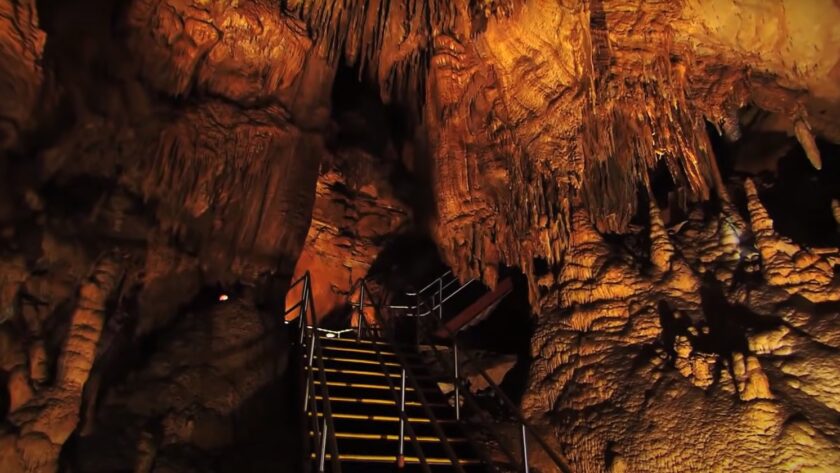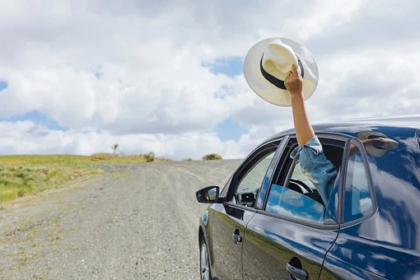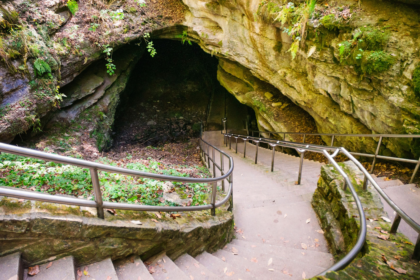Nestled in the heart of central KY, Mammoth Cave stands as a testament to nature’s intricate designs. As both a UNESCO World Heritage Site and an International Biosphere Reserve, it houses a maze of over 400 miles of explored tunnels.
Whether you’re an underground explorer or a surface adventurer, there’s something for everyone. Dive into the array of activities this site has to offer.
Top Activities in the Labyrinth of Mammoth Cave
Renowned as the world’s lengthiest explored cave system, Mammoth Cave boasts not only its intricate underground passages but also a rich landscape above. Visitors can embark on an abbreviated exploration with a concise 30-minute self-guided journey. For the truly adventurous, there are extensive tours that delve deeper into the cave’s heart.
Beyond the underground realm, the park offers an array of activities such as paddling, trekking, and equestrian adventures. Let’s discover the prime attractions of this fascinating locale.
Snapshot Overview:
- Foundation Year: 1941;
- Location: Heart of KY;
- Dimensions: Underground: over 400 miles of mapped tunnels; Surface: 53,000 sprawling acres;
- Highlights: Intricate Cave Excursions and the serene Green River.
Prime Activities at Mammoth Cave:
- Drop by the Information Hub: Initiate your journey at the Visitor Center;
- Embark on a Cave Expedition: Choose from a variety of cave tours;
- Trek Across the Landscape: Experience the surface beauty with numerous hiking trails;
- Equestrian Adventures: Delight in horseback rides across scenic trails.
With 53,000 acres of protected land, the park is divided by the tranquil Green River. The information hub and main cave excursions begin on the river’s southern side. For those looking to explore the northern realm, a ferry ride will transport you to a land of wilderness hikes, equestrian trails, and a serene camping area.
The Mammoth Cave Information Hub
Strategically situated near the historic cave entrance, the Visitor Center acts as the primary nexus for all cave explorations. Here, attendees can find tour ticket counters, an educational area, a souvenir shop, and essential amenities.
- Address: 1 Mammoth Cave Parkway;
- Timings: 9 a.m. to 5 p.m., with minor seasonal adjustments.
Diverse Cave Expeditions
From self-navigated journeys to specialized tours focusing on geological wonders, there’s an expedition for every curious soul:
Discovery Journey: Embark on a brief exploration. Primarily available in summer.
- Duration: Roughly 30 minutes, spanning 0.75 miles;
- Pricing: Adults – $8, Children – $6.
Historical Exploration: Dive deep into the cave’s rich past.
- Duration: 2 hours, navigating over 500 steps, including the expansive Mammoth Dome;
- Pricing: Adults – $20, Children – $15.
Cleaveland Avenue Expedition: A fusion of geological marvels and history.
- Duration: 2.5 hours, covering 2 miles with 400 steps;
- Pricing: Adults – $22, Children – $16.
Accessible Mammoth Exploration: Ideal for those with mobility challenges, this tour focuses on the Snowball Room and Cleavland Avenue, avoiding steps.
- Duration: 2 hours, covering 0.5 miles;
- Pricing: Adults – $22, Children – $16.
Caving Introduction: A hands-on experience with a park ranger, teaching the nuances of underground exploration.
- Duration: Over 3 hours, with a physically demanding route;
- Pricing: Adults – $35, Children – $28.
Trekking Adventures in the Park
The area surrounding the information hub boasts 7.2 miles of scenic hiking trails. While most trails are brief, the Echo River Springs Loop Trail provides a 1-mile journey. For those keen on exploring more, the park’s southern region presents 11 miles of lush trails, including the multi-purpose Mammoth Cave Railroad Hike and Bike Trail, spanning 9 miles.
Bicycling in This Historic Cave Park
Trails for Off-Road Bicyclists:
- Historic Railway Trail: *Decades ago, the 1880s to be exact, a railway system functioned in the park, carrying eager explorers until the 1930s. Today, this pathway has evolved into a 9-mile (14.4 km) multi-purpose trail;
- Hollow Heights Loop: *Stretching a slightly longer 9.1 miles (14.5 km), this pathway is split into dual loops for a varied experience.
Street Bicycling
Within this iconic cave preserve, cycling enthusiasts can traverse the vehicular roads. This fascinating site even integrates into the U.S. Bike Route System (USBRS), bridging urban and rural territories.
Journey along the USBR 76, named the TransAmerica Bike Trail, which weaves from one coastline to the other, offering an enticing detour through this cave preserve. Additionally, the Cave Country Route, USBR 23, begins at the Tennessee boundary and winds its way through the park.
Paddling
Both the Green and Nolin rivers snake through the park’s heart, making canoeing and kayaking a popular choice. Look for a licensed service provider for watercraft rentals and guided float excursions. Designed to accommodate families, these Class I voyages can be short or extend throughout the day. Operational months typically span from April through October, influenced by climatic conditions.
Equestrian Adventures
Within the park, horseback exploration under the guidance of experts is available. With a network of over 85 miles (136.7 km) of trails tailored for equestrians, the starting rates are around $25 per hour. The available durations range from an hour to two.
Riders should be minimum six years old and weigh below 250 pounds (113 kg). Booking ahead is advisable. The Double J Stables, situated at 542 Lincoln School Road, provides easy access to trailheads. Its operational hours vary seasonally. If you own horses, consider the Maple Springs Group Campground for equestrian camping, keeping park regulations in mind.
Observing Nature’s Wonders
Within the limestone sanctuary, you can spot up to 70 vulnerable species. From the diminutive Pygmy Shrew to majestic white-tail deer, and even cavern-dwelling bats, the diversity is astounding.
During the day, common sightings include chipmunks, squirrels, and raccoons. As dusk descends, animals like bobcats, weasels, and beavers emerge.
Stargazing
Experience the mesmerizing canvas of the night sky here. Enquire at the information center about potential Ranger Night Sky activities during your stay. Such celestial events are mostly scheduled on weekends throughout the year and become more frequent in summertime.
Young Explorers in the Cave’s Heart
The park’s Junior Ranger Program stands as an informative and engaging initiative for young visitors. Obtain a booklet from the park’s bookstore for just $2.00. On completing it, participants receive commemorative badges from the rangers.
Dining Near the Caverns
Adjacent to the information center, visitors have a few culinary choices:
- The Caver’s Delight Café: *Start your morning with quick picks like Greek yogurt or breakfast sandwiches. Mid-day, treat yourself to burgers and chilled beverages. Their bakery items and hand-scooped ice cream are also worth indulging in;
- The Riverside Bistro: *For those seeking a heartier meal, this establishment boasts a menu inspired by local delicacies, emphasizing fresh, regional ingredients.
Relishing Outdoor Meals in the Grand Cavern Sanctuary
There are multiple designated areas within the park premises where families and groups can enjoy outdoor meals:
- Grand Cavern Picnic Spot: Situated near the Information Hub, this vast picnic area provides visitors with a comfortable setting for outdoor dining. Two sheltered areas within this spot can be reserved in advance, making it perfect for larger groups or those seeking some shade;
- Whispering River Trail Start: The gateway to an enchanting journey, this trailhead invites nature enthusiasts to embark on a serene hike alongside the gentle sounds of a flowing river. This trail offers both scenic beauty and an opportunity to witness local flora and fauna;
- Maple Shade Recreational Area: Dotted with maple trees, this area is an idyllic setting for relaxation and leisure activities. Its canopy provides a cooling shade, making it an ideal location for picnics, reading, or simply unwinding amidst nature;
- Houchin’s Resting Point: Strategically placed along one of the park’s trails, this resting point offers hikers a chance to pause, rejuvenate, and take in panoramic views of the surrounding landscape. Benches or sitting areas may be provided for visitors to catch their breath and savor the tranquility;
- Dennison Leisure Spot: Designed with leisure in mind, this area offers visitors open spaces for recreational activities like frisbee, ball games, or simply lying down and cloud-watching. It might also feature some amenities like benches or picnic tables for added comfort;
- Sloans Pond Relaxation Zone: Centered around a serene pond, this zone offers a tranquil environment for reflection and relaxation. Visitors can watch the water ripple, listen to the soft calls of waterfowl, or even indulge in some casual fishing or pond-side reading. The water body also acts as a focal point, drawing various wildlife, making it a treat for nature enthusiasts.
Accommodations in the Grand Cavern Domain:
- The Grand Cavern Inn: With a combination of contemporary rooms and heritage lodges, the inn offers a variety of accommodation options within the park;
- Sunset Balcony: These adjoining chambers in an independent structure boast two queen-sized beds, complemented by conveniences like a mini-fridge, coffee machine, television, and internet connectivity. Furthermore, these chambers are equipped with climate control;
- Legacy Lane Chambers: Nestled within the inn, these rooms cater to individuals with disabilities. They come equipped with amenities like a mini-refrigerator, coffee brewer, television, and Wi-Fi. Moreover, they are air-conditioned for guests’ comfort;
- Timeless Retreats: These individual cottages, apt for solo travelers or couples, are equipped with basic amenities such as a mini-cooler and coffee brewer. However, they don’t offer television or internet facilities;
- Forest Huts: Being the most rustic lodging option, they lack modern conveniences like heating, air-conditioning, television, and internet. However, these come in various sizes, ranging from single to four-bedroom huts, each furnished with a mini-cooler and coffee brewer.
Camping in the Grand Cavern Region:
- Grand Cavern Campsite: Operational from the onset of March until the end of November, it is wise to book your spot in advance at this expansive 111-site camping area, which boasts a waste disposal point, laundry facilities, drinkable water sources, modern restrooms, and warm shower facilities;
- Houchin’s Retreat Campsite: A reservation is essential for this exclusive 12-site camping area, meant specifically for tents. Despite its seclusion, it offers potable water and mobile restrooms;
- The Grand Cavern’s Chronicle: On the 1st of July in 1941, the Grand Cavern Domain was officially recognized, and later, on October 27, 1981, it secured its place as a UNESCO World Heritage Site. Further underlining its global significance, it was designated an International Biosphere Reserve on September 26, 1990.
The Inhabitants of the Grand Cavern
Shelters within caverns have drawn humans for millennia, with traces of human activities tracing back approximately 12,000 years:
- Indigenous Peoples’ Legacy: Around 1200 BCE, the caverns became sites for mineral extraction, particularly gypsum. Evidence from this era, including torch remains, engraved images, and paintings, offers insights into their activities. Currently, whenever new relics are unearthed, seven prominent tribes of the Southeast Woodlands are consulted. These tribes include the Cherokee Nation, Eastern Band of Cherokee Indians, United Keetoowah Band of Cherokee, the Shawnee Community, Eastern Shawnee from Oklahoma, Absentee Shawnee, and the Chickasaw Nation;
- African-American Chronicles: Extraction activities persisted into the 18th century, focusing on procuring gunpowder ingredients from the caverns. Following the Civil War, a few intrepid men ventured deeper into the caverns. Their explorations were foundational as tourism interest surged.
Pioneers like Stephen Bishop, and siblings Mat Bransford and Nick Bransford, carved out pathways within the Grand Cavern. Descendants of these trailblazers continued guiding visitors until its national recognition and official protections.
The Conservation Brigade
Emerging from President Roosevelt’s groundbreaking Works Progress Initiative, the Conservation Brigade, also known as the Civilian Conservation Corps, was instrumental in shaping America’s natural legacy. Comprising enthusiastic young men aged 18 to 25, they were entrusted with vital conservation tasks in national reserves such as developing pathways, fortifying infrastructure, and afforestation. Their compensation was modest: $30 monthly, with $25 being forwarded to their households. These diligent men were provided shelter in tents, daily sustenance, uniforms, and invaluable training in various trades.
In the vast underground wonder, commonly referred to as Mammoth Cave, the impact of four Conservation Brigade encampments is palpable even today. Notably, Camp #1 witnessed the synergy of Bransford’s lineage working alongside compatriots from diverse regions. Their tenure at the cave was marked by the construction of enduring edifices, the planting of over a million trees, and meticulous development and enhancement of 24 miles of subterranean pathways, including the illustrious entrance known as the Frozen Niagara.
Reaching The Mammoth Cave
This awe-inspiring natural reserve remains accessible around the clock, 365 days a year. While there’s no charge to enter the park itself, explorers wishing to delve deep into the cave’s secrets would need to secure a tour ticket. The location of this grand underground expanse is approximately 100 miles to the south of Louisville and a mere 10 miles away from Cave City.
Within the boundaries of the park, the Green River Ferry facilitates transit to the northern terrains of the Subterranean Marvel. Its services are available from 6 a.m. to 10 p.m.; however, prospective travelers should note that the ferry’s operations are subject to river conditions and potential flooding.
In Retrospect
The significance of initiatives like the Conservation Brigade is evident in the preserved beauty and expansive growth of natural reserves like Mammoth Cave. Such historic efforts, combined with the cave’s mesmerizing beauty and accessible amenities, make it a shining beacon in America’s rich tapestry of natural wonders.
Visitors to this awe-inspiring location are not just exploring a cave, but also journeying through time, witnessing the fruition of conservation projects from decades past. The legacy of the Conservation Brigade and the splendor of nature intertwined make this destination a must-visit for all nature and history enthusiasts.




